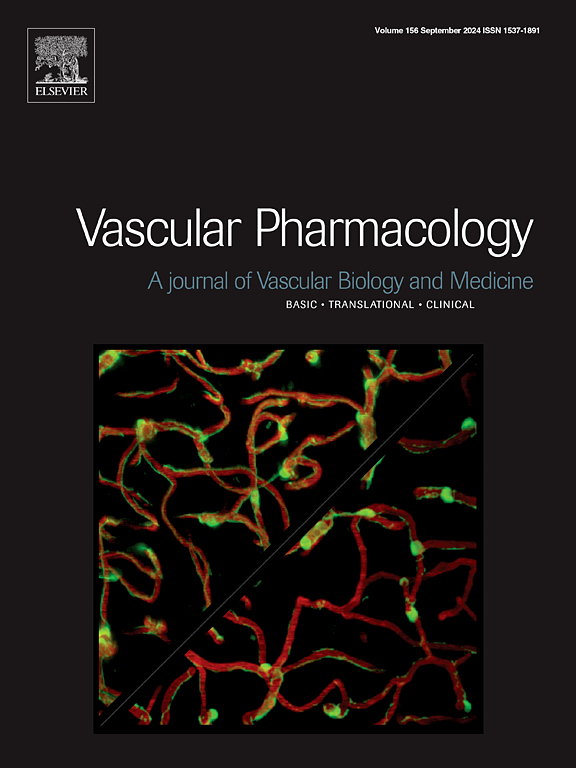急性心肌梗死后循环脂多糖和糖粘蛋白的变化:吸烟的影响
IF 3.5
3区 医学
Q2 PHARMACOLOGY & PHARMACY
引用次数: 0
摘要
血清脂多糖(LPS)是肠道生态失调和内毒素血症的标志物,与心肌梗死(MI)有关。我们研究了经皮冠状动脉介入治疗(PCI)后心肌梗死患者LPS变化的影响因素,旨在确定心肌梗死后LPS下降程度的相关因素。方法在46例PCI治疗的心肌梗死患者(平均年龄57.2[8.6]岁)入院时、入院后30和60天测量了LPS和zonulin(一种肠道通透性标志物)、炎症标志物(白细胞介素[IL]-6、IL-18)、p -选择素和8-异前列腺素F2α (8-isoPGF2α)。结果LPS初始浓度中位数为44.0 (37.0 ~ 57.0)pg/mL, 1个月后下降11.3%,2个月后进一步下降8.3%,与zonulin有关,但与p -选择素或炎症标志物无关。基线LPS和zonulin与8-isoPGF2α呈正相关。& lt;20例(43.5%)患者LPS下降10%,在吸烟者、梗死相关动脉(IRA)完全闭塞和PCI前症状持续时间较短的患者中更常见。心肌梗死后30天和60天,脂多糖降低10%与IL-10浓度下降有关。在多变量分析中,只有当前吸烟和首次完全阻断IRA与1个月时脂多糖降低10%独立相关(OR 10.44;95% ci 2.13-51.21;p = 0.004, OR = 6.59;95% ci 1.21-35.88;P = 0.029)。本研究首次揭示了影响心肌梗死后LPS变化的因素,强调了吸烟和初始完全IRA闭塞在心肌梗死后持续低级别内毒素血症中的作用。本文章由计算机程序翻译,如有差异,请以英文原文为准。
Changes in circulating lipopolysaccharide and zonulin following acute myocardial infarction: The impact of smoking
Background
Serum lipopolysaccharide (LPS), a marker of gut dysbiosis and endotoxemia is associated with myocardial infarction (MI). We investigated factors affecting LPS changes in MI patients treated with percutaneous coronary intervention (PCI) and aimed to establish factors associated with the degree of LPS decrease following MI.
Methods
In 46 PCI-treated MI patients (mean age 57.2 [8.6]) years we measured LPS and zonulin, a marker of gut permeability, on admission, 30 and 60 days thereafter, inflammatory markers (interleukin [IL]-6, IL-18), P-selectin, and 8-isoprostaglandin F2α (8-isoPGF2α).
Results
The median initial LPS concentration was 44.0 (37.0–57.0) pg/mL and it fell by 11.3 % at 1 month, with a further 8.3 % drop after the second month, in association with zonulin, but not with P-selectin or inflammatory markers. LPS and zonulin at baseline correlated positively with 8-isoPGF2α. A < 10 % decrease in LPS was recorded in 20 (43.5 %) patients and was more frequent in smokers, those with a complete occlusion of the infarct-related artery (IRA) and a shorter symptom duration before PCI. LPS decrease <10 % was associated with a decline in IL-10 concentrations 30- and 60-days post MI. On multivariate analysis only current smoking and an initial complete IRA occlusion were independently associated with <10 % decrease in LPS at 1 month (OR 10.44; 95 % CI 2.13–51.21; p = 0.004 and OR 6.59; 95 % CI 1.21–35.88; p = 0.029, respectively).
Conclusions
This study is the first to show factors affecting post-MI changes in LPS, highlighting the role of smoking and initial complete IRA occlusion in persistent low-grade endotoxemia following MI.
求助全文
通过发布文献求助,成功后即可免费获取论文全文。
去求助
来源期刊

Vascular pharmacology
医学-药学
CiteScore
6.60
自引率
2.50%
发文量
153
审稿时长
31 days
期刊介绍:
Vascular Pharmacology publishes papers, which contains results of all aspects of biology and pharmacology of the vascular system.
Papers are encouraged in basic, translational and clinical aspects of Vascular Biology and Pharmacology, utilizing approaches ranging from molecular biology to integrative physiology. All papers are in English.
The Journal publishes review articles which include vascular aspects of thrombosis, inflammation, cell signalling, atherosclerosis, and lipid metabolism.
 求助内容:
求助内容: 应助结果提醒方式:
应助结果提醒方式:


